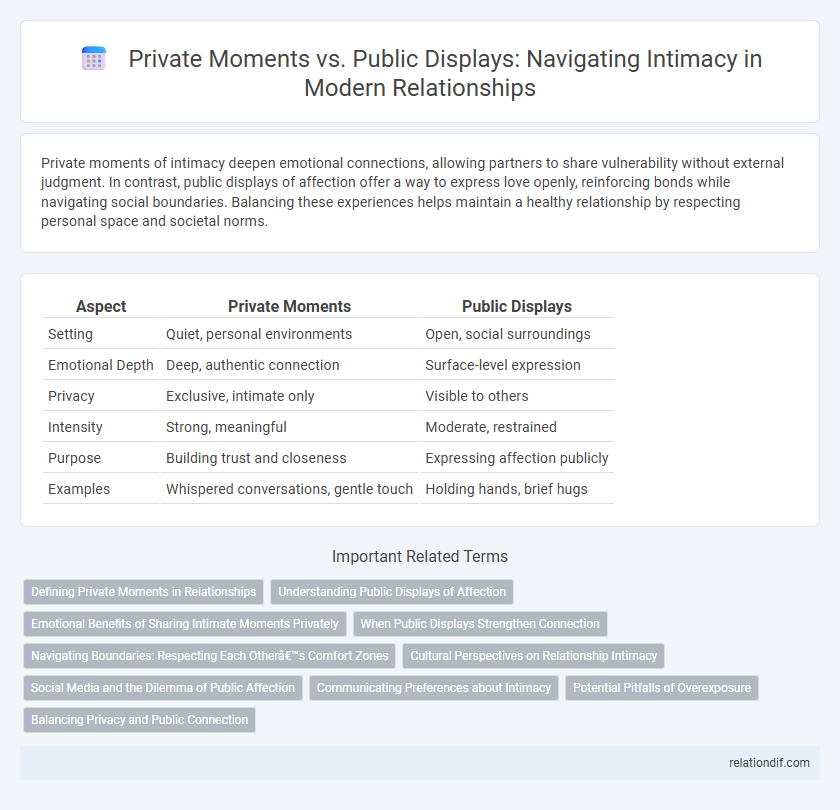Private moments of intimacy deepen emotional connections, allowing partners to share vulnerability without external judgment. In contrast, public displays of affection offer a way to express love openly, reinforcing bonds while navigating social boundaries. Balancing these experiences helps maintain a healthy relationship by respecting personal space and societal norms.
Table of Comparison
| Aspect | Private Moments | Public Displays |
|---|---|---|
| Setting | Quiet, personal environments | Open, social surroundings |
| Emotional Depth | Deep, authentic connection | Surface-level expression |
| Privacy | Exclusive, intimate only | Visible to others |
| Intensity | Strong, meaningful | Moderate, restrained |
| Purpose | Building trust and closeness | Expressing affection publicly |
| Examples | Whispered conversations, gentle touch | Holding hands, brief hugs |
Defining Private Moments in Relationships
Private moments in relationships serve as intimate spaces where partners share genuine emotions, fostering trust and deep connection beyond public appearances. These moments often include personal conversations, subtle gestures, and shared experiences that cultivate emotional security and vulnerability. Defining private moments involves recognizing their role in reinforcing relational bonds away from societal scrutiny and external judgments.
Understanding Public Displays of Affection
Public displays of affection (PDA) encompass actions like holding hands, hugging, or kissing in social settings, signaling emotional connection openly. Understanding cultural norms around PDA is essential, as acceptance varies widely across regions and social groups, influencing comfort levels. Navigating these expressions helps balance personal intimacy with social appropriateness, fostering respect for individual boundaries and societal expectations.
Emotional Benefits of Sharing Intimate Moments Privately
Sharing intimate moments privately fosters deeper emotional connections by creating a safe space for vulnerability and trust, which public displays often lack due to social pressures. Private intimacy enhances emotional security, allowing individuals to express genuine feelings without judgment, thereby strengthening relational bonds. This confidentiality nurtures emotional resilience and mutual understanding, essential components for long-term relationship satisfaction.
When Public Displays Strengthen Connection
Public displays of affection, such as holding hands or sharing a brief kiss, can strengthen connection by signaling commitment and security to both partners and observers. These moments create a shared experience that reinforces emotional intimacy and trust, especially in long-term relationships. Research shows that couples who engage in appropriate public displays often report higher relationship satisfaction and a deeper sense of belonging.
Navigating Boundaries: Respecting Each Other’s Comfort Zones
Navigating boundaries in intimacy requires clear communication and mutual respect for each partner's comfort zones, distinguishing private moments from public displays. Understanding individual preferences ensures that expressions of affection align with both partners' emotional safety and social contexts. Establishing these limits fosters trust and deepens connection while honoring personal and cultural values.
Cultural Perspectives on Relationship Intimacy
Cultural perspectives on relationship intimacy vary significantly, influencing the balance between private moments and public displays of affection. In many Western societies, public displays of affection are generally accepted as expressions of trust and emotional connection, while in several Asian and Middle Eastern cultures, intimacy is often reserved for private settings to maintain social harmony and respect. Understanding these cultural norms is essential for navigating relationship expectations and fostering cross-cultural empathy.
Social Media and the Dilemma of Public Affection
Private moments of intimacy foster deep emotional connections, whereas public displays of affection on social media often invite scrutiny and misinterpretation. The dilemma of public affection involves balancing authenticity with privacy, as sharing romantic gestures online can blur boundaries between genuine connection and performative acts. Navigating this tension requires couples to set personal limits that protect their intimacy while engaging with their digital audience.
Communicating Preferences about Intimacy
Communicating preferences about intimacy involves clearly expressing comfort levels regarding private moments and public displays of affection to build mutual understanding. Establishing boundaries helps partners navigate personal space and social settings, fostering respect and emotional connection. Open dialogue about what feels appropriate enables couples to maintain balance between intimacy and social norms.
Potential Pitfalls of Overexposure
Excessive public displays of intimacy can lead to social discomfort, misunderstandings, and strained relationships due to cultural norms and personal boundaries being overlooked. Private moments preserve emotional vulnerability and trust, fostering deeper connections without external judgment or scrutiny. Overexposure risks diminishing the authenticity of intimate experiences, making them seem performative rather than genuine expressions of affection.
Balancing Privacy and Public Connection
Balancing privacy and public connection in intimacy requires thoughtful navigation of private moments and public displays of affection. Private moments foster deep emotional bonds through vulnerability and trust, while public displays of connection communicate commitment and affection to others. Respecting personal boundaries and cultural norms ensures that intimacy remains genuine without compromising the couple's comfort or social dynamics.
Private moments vs public displays Infographic

 relationdif.com
relationdif.com